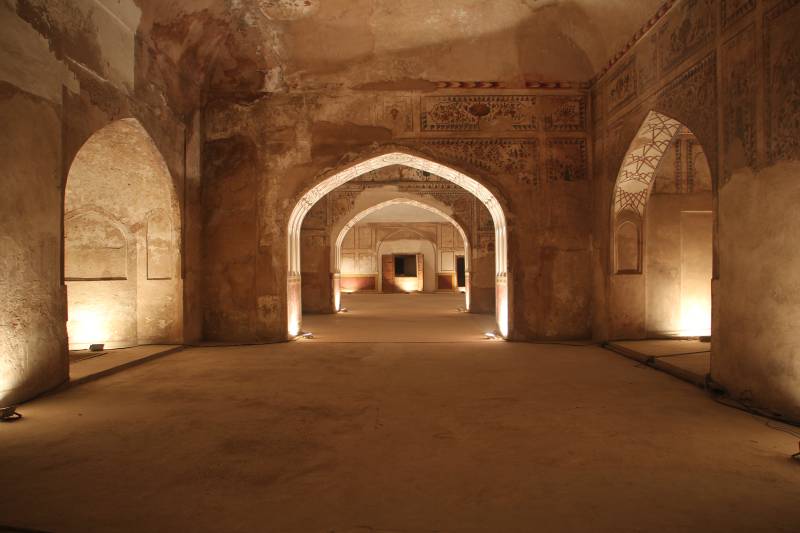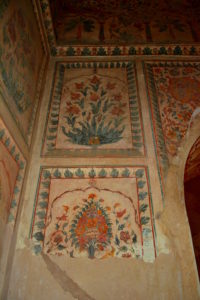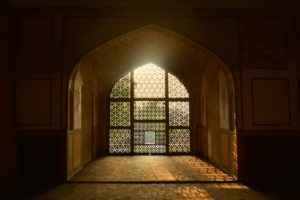
Tania Qureshi takes the readers inside Summer Palace, a little known space inside the Sheesh Mahal of Lahore Fort. The well-constructed palace was used as a summer house by the royal families and its mesmerizing appearance tells tales of bygone days.
Have you ever been to the Summer Palace of the Lahore Fort? I am sure very few of us know about this hidden jewel which is the massive basement of Sheesh Mahal, the house of mirrors, inside Lahore Fort. The summer palace and Sheesh Mahal were known as jewel palaces in 1631. You will be surprised to know that Summer Palace was also known as Pari Mahal (Fairy Palace) but now no one knows much about it. It was a closed space inside Lahore Fort and was not visited by the tourists. This is one reason why most people do not know about this mesmerizing space inside the huge Lahore Fort.
You must be thinking how to reach this palace. You don’t really have to go to Sheesh Mahal to reach this basement. When you enter from the postern gate of Lahore Fort, which is a British era gate, you will come across the Shah Burj Gate. From this gate you take left onto the elephant stairs and there, a small door on the left will welcome you to this massive basement. The twisted palace was built to thwart plans of potential attackers.

This palace was built by Mughal Emperor Shah Jahan as a summer house for the Royal families. An interesting fact about it is that as you enter the palace, you will be welcomed by cool breeze, even in peak summers. The palace was constructed in such a way as to ensure that it has good ventilation.
You will be stunned to see this labyrinth and maze like basement with tunnels on corners. I guess these tunnels must have been the escape route of the royal families in case of any attacks or riots. It is said that the escape tunnels in palaces usually led to the river from where the royals escaped on boats in case of war or attack by an enemy. Similarly, it is said that the tunnels in the summer palace led to River Ravi which was flowing near the Lahore Fort in those times. The boats of the Royal family were parked near the river and in case of any attack they would have escaped through these tunnels. While standing in this palace you will be able to visualize this scene.
Let me tell you that there is no light in this palace and the only source of light is the small windows from where natural light enters. For lighting, oil lamps with coconut oils were used there and we can still see the hooks that held the oil lamps or diyas.
The palace like other Shah Jahan era monuments in Lahore Fort is lavishly decorated and gives a colorful feel because of the fresco art. There is original fresco work inside the palace and the walls along with the ceilings were ornamented with silver, gold and fresco. Gold and silver is not seen now as it is said that during the Sikh and British rule, the places inside Lahore fort were looted and destroyed.
Now let me tell you another interesting fact about this palace. The ceilings have no iron or wooden beams or even the cement, rather these are made of grams, white lentils, clay, jiggery, eggs, dried grass, lime plaster and small bricks (the ones found in all Mughal monuments). This mortar works like glue keeping the small bricks intact and place cold and also helped in preventing the place from insects.
I wonder how the Mughals attained this perfection in building huge monuments. The same mortar is found in different Mughal era buildings and that is one reason we find pigeons sitting and eating the mortar in old places.
Another mind blowing feature of this palace is the echo system. If you are standing in one corner your whisper can be clearly heard by the person standing in the other corner of the same room. This mechanism is also found in the Shahi Hammam located inside Delhi Gate and the Badshahi Mosque. It is said that this unique technique was used during Mughal times to keep an eye on conspiracies and overhear any gossip they may engage in.
Now come to the amazing floor of this palace. Underneath the floor is another one and between the two floors a sewerage system was laid through which the water of river Ravi ran, keeping the floors cold. This is why the palace remained pleasant in summers. You will not see any seepage there and it is a well intact palace and better in condition as well.
During the British rule, the Summer Palace was given a new entrance from the elephant stairs which we use now. Most of its ornaments were damaged during the Sikh period. The floor of the palace was repaired in early 1900s as it was damaged over time.
Initially the Sheesh Mahal was used to get into the basement but at present those stairs are derelict and closed for the public. Sheesh Mahal has two openings that lead to the summer palace.

There is also a mezzanine floor in the palace which was the private chamber of the king. It is a small room and the king would sit there to watch over the enemies and the troops from a small window.
It is said that there were forty two water cascades and fountain systems inside the Summer Place and all were non-functional at present as they have not been used since ages. It is said by the historians and story tellers that special scents and rose water was mixed in water channels so that the palace remained perfumed with different aromas. The water of these fountains ran underneath the floor of summer place and was drained out into the river.
The fountains in the summer palace were made from very expensive stones which were brought from different parts of the world. These were damaged during the riots and transitions through which the palace went. The palace was also decorated with the intricate marble inlay work known as pietra dura art. A well was also made inside the summer palace which is all dried up now, but in old times, it was used for fresh water. The marks of fountains and well can be seen there in the palace.
The palace is open to public during the history by night tours which are conducted by the Walled City of Lahore Authority. The tourists are now taken into this beautiful palace and are given a guided tour as well.
The entire palace is illuminated for the tourists so that they can look at the intricate design and structure of this place. It is no doubt a mesmerizing piece of architecture.
Have you ever been to the Summer Palace of the Lahore Fort? I am sure very few of us know about this hidden jewel which is the massive basement of Sheesh Mahal, the house of mirrors, inside Lahore Fort. The summer palace and Sheesh Mahal were known as jewel palaces in 1631. You will be surprised to know that Summer Palace was also known as Pari Mahal (Fairy Palace) but now no one knows much about it. It was a closed space inside Lahore Fort and was not visited by the tourists. This is one reason why most people do not know about this mesmerizing space inside the huge Lahore Fort.
You must be thinking how to reach this palace. You don’t really have to go to Sheesh Mahal to reach this basement. When you enter from the postern gate of Lahore Fort, which is a British era gate, you will come across the Shah Burj Gate. From this gate you take left onto the elephant stairs and there, a small door on the left will welcome you to this massive basement. The twisted palace was built to thwart plans of potential attackers.

A chamber of the Summer Palace
This palace was built by Mughal Emperor Shah Jahan as a summer house for the Royal families. An interesting fact about it is that as you enter the palace, you will be welcomed by cool breeze, even in peak summers. The palace was constructed in such a way as to ensure that it has good ventilation.
You will be stunned to see this labyrinth and maze like basement with tunnels on corners. I guess these tunnels must have been the escape route of the royal families in case of any attacks or riots. It is said that the escape tunnels in palaces usually led to the river from where the royals escaped on boats in case of war or attack by an enemy. Similarly, it is said that the tunnels in the summer palace led to River Ravi which was flowing near the Lahore Fort in those times. The boats of the Royal family were parked near the river and in case of any attack they would have escaped through these tunnels. While standing in this palace you will be able to visualize this scene.
Let me tell you that there is no light in this palace and the only source of light is the small windows from where natural light enters. For lighting, oil lamps with coconut oils were used there and we can still see the hooks that held the oil lamps or diyas.
Three windows are the only source of light in the palace
The palace like other Shah Jahan era monuments in Lahore Fort is lavishly decorated and gives a colorful feel because of the fresco art. There is original fresco work inside the palace and the walls along with the ceilings were ornamented with silver, gold and fresco. Gold and silver is not seen now as it is said that during the Sikh and British rule, the places inside Lahore fort were looted and destroyed.
Now let me tell you another interesting fact about this palace. The ceilings have no iron or wooden beams or even the cement, rather these are made of grams, white lentils, clay, jiggery, eggs, dried grass, lime plaster and small bricks (the ones found in all Mughal monuments). This mortar works like glue keeping the small bricks intact and place cold and also helped in preventing the place from insects.
I wonder how the Mughals attained this perfection in building huge monuments. The same mortar is found in different Mughal era buildings and that is one reason we find pigeons sitting and eating the mortar in old places.
Another mind blowing feature of this palace is the echo system. If you are standing in one corner your whisper can be clearly heard by the person standing in the other corner of the same room. This mechanism is also found in the Shahi Hammam located inside Delhi Gate and the Badshahi Mosque. It is said that this unique technique was used during Mughal times to keep an eye on conspiracies and overhear any gossip they may engage in.
Now come to the amazing floor of this palace. Underneath the floor is another one and between the two floors a sewerage system was laid through which the water of river Ravi ran, keeping the floors cold. This is why the palace remained pleasant in summers. You will not see any seepage there and it is a well intact palace and better in condition as well.
During the British rule, the Summer Palace was given a new entrance from the elephant stairs which we use now. Most of its ornaments were damaged during the Sikh period. The floor of the palace was repaired in early 1900s as it was damaged over time.
Initially the Sheesh Mahal was used to get into the basement but at present those stairs are derelict and closed for the public. Sheesh Mahal has two openings that lead to the summer palace.

Walls decorated with fresco work
There is also a mezzanine floor in the palace which was the private chamber of the king. It is a small room and the king would sit there to watch over the enemies and the troops from a small window.
It is said that there were forty two water cascades and fountain systems inside the Summer Place and all were non-functional at present as they have not been used since ages. It is said by the historians and story tellers that special scents and rose water was mixed in water channels so that the palace remained perfumed with different aromas. The water of these fountains ran underneath the floor of summer place and was drained out into the river.
The fountains in the summer palace were made from very expensive stones which were brought from different parts of the world. These were damaged during the riots and transitions through which the palace went. The palace was also decorated with the intricate marble inlay work known as pietra dura art. A well was also made inside the summer palace which is all dried up now, but in old times, it was used for fresh water. The marks of fountains and well can be seen there in the palace.
The palace is open to public during the history by night tours which are conducted by the Walled City of Lahore Authority. The tourists are now taken into this beautiful palace and are given a guided tour as well.
The entire palace is illuminated for the tourists so that they can look at the intricate design and structure of this place. It is no doubt a mesmerizing piece of architecture.

